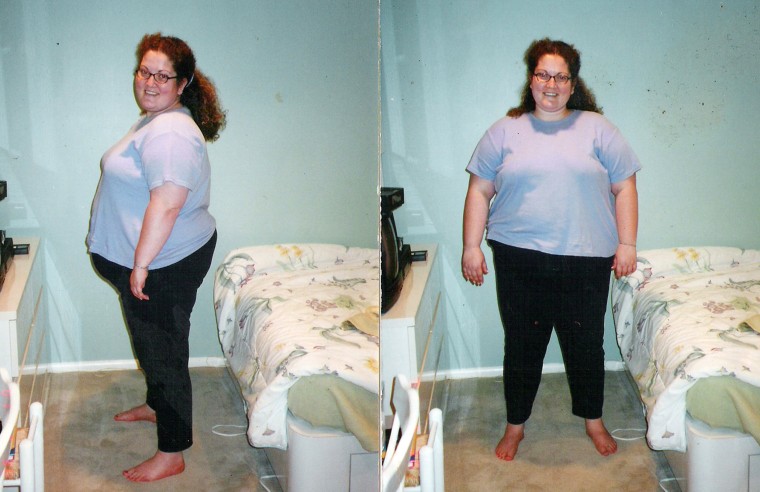As an eating disorders therapist who couldn’t control her own weight, Molly Carmel was desperate to get a hold on the problem.
She spent years trying most every diet and exercise program, and underwent bariatric surgery, but nothing worked in the long-term. At 5 feet 7 inches tall, she reached 325 pounds in her 20s. Through it all, one food was a constant.
“I would turn to sugar — of course I would. It soothed me, it numbed me, it comforted me,” Carmel, now 42 and author of the new book, “Breaking Up With Sugar: Divorce the Diets, Drop the Pounds, and Live Your Best Life,” told TODAY.
“It was my great love… I thought it was my solution when it was really my problem.”

It started when she was a child. If Carmel went to the amusement park, she couldn’t get to the churros fast enough. When she went to a friend’s house, the big draw was eating cookies. By the time Carmel was 7, her family put her on her first diet, concerned that she was “chunky,” she recalled.
She entered the familiar cycle of dieting, losing weight, having the diet fail, feeling demoralized and turning to sweets for comfort. By the time she reached her maximum weight at 23, she couldn’t tie her shoe laces or walk more than a few steps without being short of breath.
“It was terrible,” Carmel said. “I was hopeless, I stopped seeing my friends, I stopped traveling, I was very reclusive at that time.”
Bariatric surgery helped her lose 100 pounds at first, but the medical procedure didn't solve what she called a deeply behavioral and emotional problem, so she “ate through” it and started regaining the weight.
It was the end of the 1990s, when the low-fat diet ruled and Carmel remembers eating lots of honey mustard pretzels and frozen yogurt.
That’s when she started researching sugar and decided to quit it cold turkey, inspired by her brother who was the first to give up sweets. Carmel thought it would just be a brief fad diet, but when it started working, she stuck with it.

“I don’t think I recognized what a true enemy sugar was. That’s the bait-and-switch that comes with sugar — the short-term,” said Carmel, who is also a licensed clinical social worker and founder of The Beacon Program, a treatment center for binge eating and food addiction in New York.
“I never recognized that in the long-term, it was incredibly abusive and holding me back from virtually everything I was trying to do.”
After about a year of avoiding added sugar, Carmel dropped to 150 pounds, a weight she has maintained for about 10 years. Experts warn eating plans that are too rigid usually don't work, but Carmel found it to be the right fit for her.
Here are her tips for breaking up with sugar:
1. Closely examine your relationship with sweets
Take a look at what you’re eating and identify the sugar problem spots. Is it first thing in the morning when you need an ultra-sweet coffee to go with your glazed donut? Is it the chocolate bar during your 3 o’clock break, or are you craving cake late at night?
Think how you can switch out foods during those times to get rid of the sugar. A good option is fruit, which has vitamins and fiber, but not fruit juice, which is “straight sugar,” Carmel said.
Love the food you’re eating and find food that loves you back, she noted. Look for options that come from the earth, like fruits, vegetables and grains.
2. Always read food labels
Added sugar is in everything — from pasta sauce to oatmeal — so it’s really a commitment to be aware of what’s really in the food you’re eating.
Carmel checks every single label to look for sugar and all 61 of its aliases. She has a “fifth ingredient rule,” which says if sugar is the fifth ingredient or lower on the list, that food is good to go.
3. Forget about ‘cheat days’
Many eating regimens allow people to break the rules once in a while, but there’s a biochemical activation that happens on cheat days, Carmel warned.
“You re-ignite that love and taste for sugar,” she said. “I have very rarely seen somebody who is successful with just a cheat day — it’s usually more like a cheat week or a cheat month.”
Idealizing abusive foods like sugar as once-a-week treats is problematic, she added. Just commit to sticking to the rules.
4. Don’t count on exercise to help
“To me, exercise is wonderful for your health. But exercise is not the solution to a sugar addiction,” Carmel said.
She likes working out to boost mood and well-being, but doesn’t credit it as a major ingredient in her weight loss.
5. Don’t have sweets in the house
It’s much easier to avoid sugar if there aren’t any sweets conveniently stored in the pantry.
“That’s a big one. If I kept shortbread in my house, I very likely would be eating it,” Carmel said. Just don’t buy foods that “speak to you in the middle of the night,” she noted. She’s also highly critical of artificial sweeteners.
Her favorite technique to fight a sugar craving in the moment is to put ice on the back of her neck. She swears it works.
6. Make the break-up with sugar permanent
Carmel doesn’t want this to be a 30-day challenge, but a lifetime commitment. People can’t imagine how good it can feel because they’re caught up with their relationship with sugar.
“This is a decision I would make over and over and over again. I’m only sad that I didn’t make it sooner. The kind of freedom that I know today is a freedom I never thought possible,” she said.

